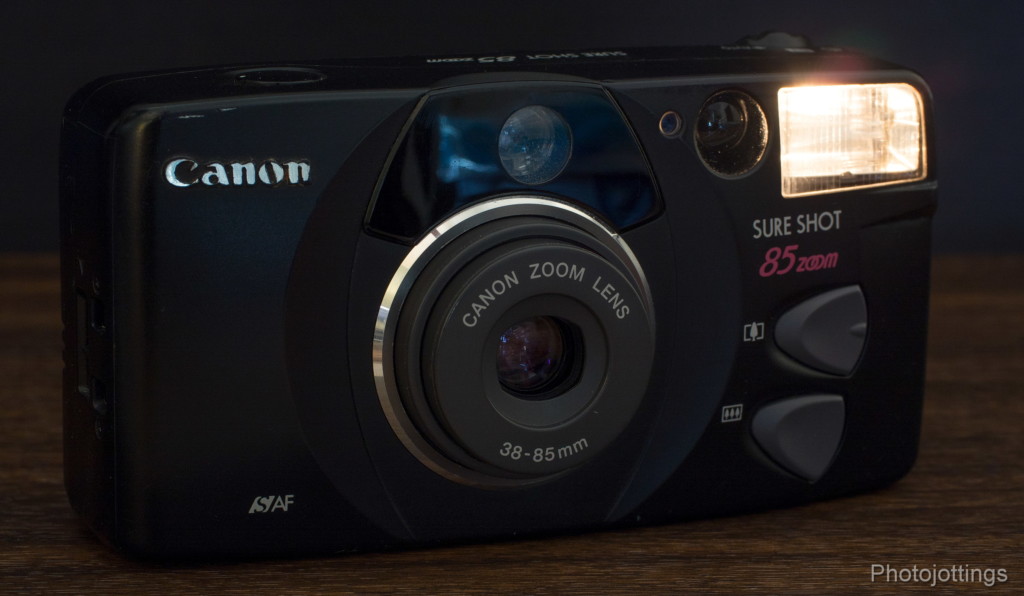
So one morning my neighbor walks up to me with this camera and wants to know if it has any film in it. I looked in the little window slit in the back and saw no film, and then opened the back to show her. I asked her if she was going to take some pictures, and she said no, I’m going to throw it away. Of course she ended up giving it to me; and so I added this Canon Sure Shot Zoom 85 to my collection!!
This late 90s black beauty is actually a swell camera; the lens quality is better than what I would’ve guessed, especially for a zoom; it has a 6/6 design with one aspherical element. Other nice features include excellent AF accuracy and exposure metering, a good zoom range, and a ‘real time’ shutter setting for super quick snaps!
Pick up one of these for a song, (or even less like me), or around $10-20 for a good used copy on ebay.
The Canon marketing pamphlet states: “Here’s a camera that makes it so easy to reach a new level of picture-taking excellence. A camera that’s so compact and stylish, you’ll always want it with you… for the moments you don’t want to miss. Slip the Sure Shot 85 Zoom into your pocket and get ready for great times, and great pictures!” So in other words, if you buy this camera, you’ll be ‘ready’ to have great times, and great pictures, but maybe you won’t. You might end up having mediocre times, and bad pictures, just like everyone else.
Is this the camera we’ve all been dreaming of, or is it just another uninspiring cheap camera for the masses? Either way, let’s take a closer look at the Canon Sure Shot Zoom 85.
Name; Canon Sure Shot Zoom 85; called Autoboy Luna 85 in Japan, and Prima Zoom 85 in Europe.
Manufactured by; Canon Inc. Tokyo, Japan. Made in China.
Date of manufacture; late 1998, through 2002?
Price; retail around $250+ in 1998; probably less at large discount stores. Current ebay prices are around $10-20 for a good used copy, or less than $60 for a brand new one in the box; depending on availability.
Other versions; there is a ‘Platinum’ colored model out which seems to be more popular than the Black model. Also, both come either with, or without a ‘Date’ back: Canon says models with the date back and panorama mode are available only in areas outside of the USA. The ‘Date’ back calendar ends in 2019, so hurry and buy one before that feature is useless!
Build material; plastic body with a clear plastic window over the view finder, flash signal, and film reminder slot.
Weight and size; camera with batteries, 8.3oz (236g). Camera only 7.7 oz (219g).
Dimensions; Size is 4.8″ (123mm) wide, 2.5″ (64mm) high, and 1.7″ (42mm) deep.
Focal length; 2.2x zoom from 38-85mm.
Aperture; maximum aperture at 38mm is F/4.2; maximum at 85mm is F/8.7.
Focusing; artificial intelligence -smart- (Saf), (aiaf) 3 point auto focus, (one point in RT mode), manual states from 2.0′ (0.6m).
Original print size; standard oversize prints 4″ x 6.″
Approximate resolution; will make excellent 5″x 7,” and good to excellent 8″x 10″ prints.
Lens; coated glass six elements in six groups design, with one apherical lens element. 38-85mm focal length, F/4.2-8.7 maximum aperture. The zoom feature has five settings, probably about 38mm, 45mm, 55mm, 70mm, and 85mm. There are no in-between settings.
Shutter and speed; program type electromagnetic shutter and aperture. Two seconds at maximum apertures in flash-off mode. In auto/flash-on/self timer modes; wide end; 1/36 sec at F/4.2, 1/500 seconds at F/34. Telephoto end; 1/83 seconds at F/8.7, 1/500 at F/34. Self timer with flash use; 1/2 seconds to 1/36 at the wide end, and 1/2 second at the long end.
Distortion; mild type pincushion at 38mm, 85mm looks pretty straight.
Color fringing; mild to moderate magenta colored lateral type.
Features; auto load, auto advance, auto rewind, flash on or off position, red-eye reduction lamp, zoom lens, auto focus, ‘real time’ shutter setting, auto film DX coding, tripod socket and self timer.
Film; all 135 film cartridges, B&H, Amazon, eBay.
Flash. Guide number of 13.4 at ASA 100. Recharges in 4-5 seconds with fresh battery.
Power; One CR123A 3v battery, lasts for about 10 rolls of 36 using the flash every other shot. Usually available at big box stores or drug stores, but super expensive. Get them much cheaper here: B&H, Amazon, eBay.
Viewfinder; small, with decent brightness, but no guidelines except parallax correction. Has a middle auto focus framing box.
DX coding; from ISO 25-3200. Non DX coded film is registered as ISO 25.
Accessories for this model; none that I know of.
Crippling features and omissions; mode dial is hard to turn unless using two hands holding the camera, and two fingers to turn it. Two seconds max shutter speed is too short for the small maximum apertures of this camera; so good night shots on a tripod may require ISO 800-1600 film.
Good features; accurate and reasonably fast AF, and sharp lens at all focal lengths.
Product shots with descriptions. Click for larger images.

The Canon Sure Shot Zoom 85 shown with the automatic lens cover closed. The circular window above the lens is the viewfinder. The little round widow to the right is for metering. The large circular window next to the flash is the auto focus light receptor, with the light emitter to the left of the viewfinder, (hard to see in this picture). The gray buttons are for zooming in and out.
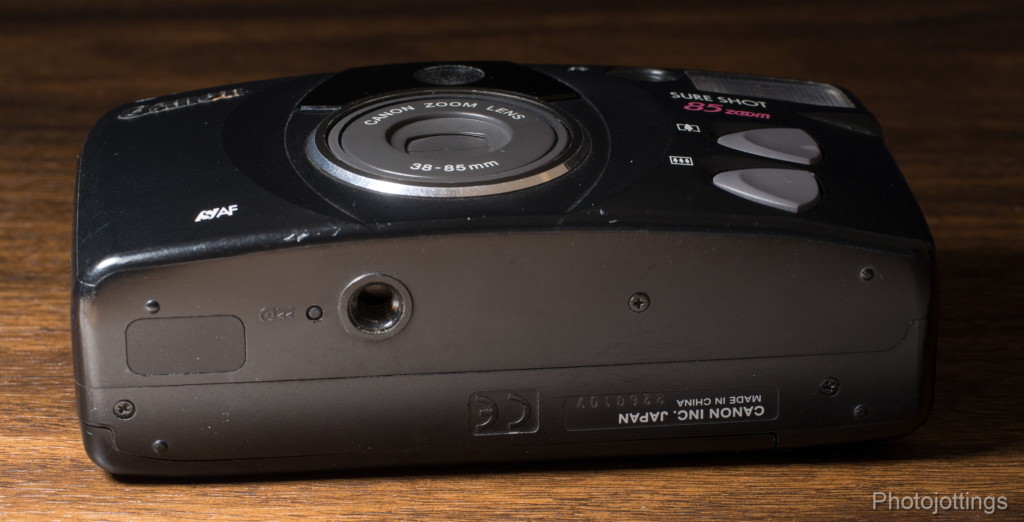
The only two items on the bottom are the tripod socket and tiny mid-roll rewind button.
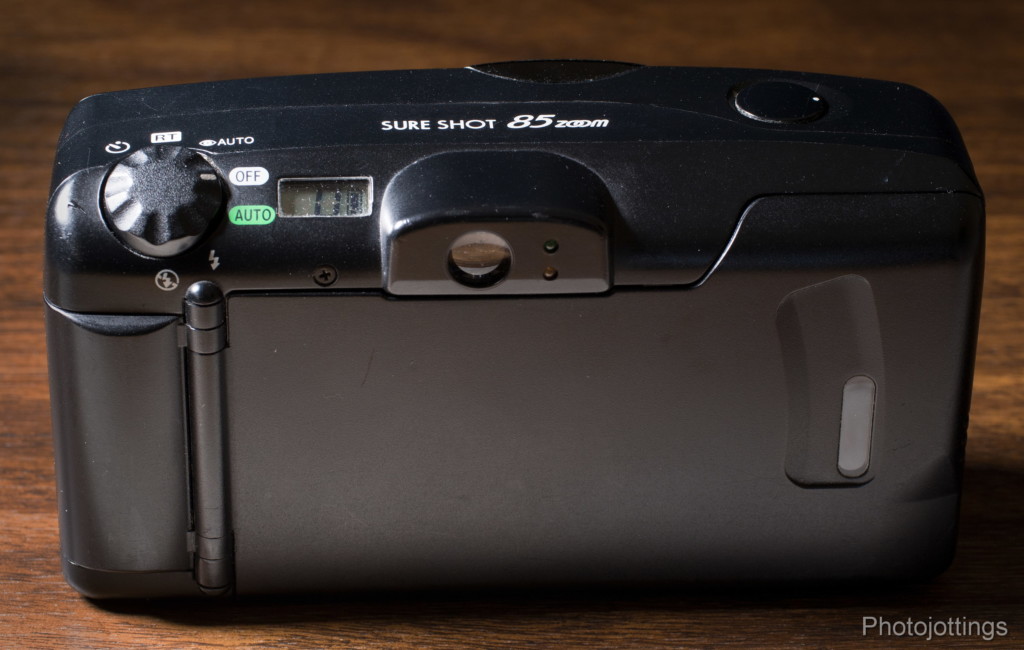
On top we have the circular viewfinder located dead center. The two little lights stacked next to it are for focus lock (top green lite), and shake (low shutter speed) warning in flash off mode (bottom orange lite), and flash charge on auto modes. To the left is the LCD window which shows battery life, and shot count. The mode dial on the left has the following settings: the upper most setting is the 10 second self timer; next is “RT” is for ‘real time’ shooting, which sets the AF first, and then releases the shutter in 0.03 seconds after pressing the shutter button. Following the ‘RT’ setting is ‘auto’ mode with red-eye reduction. Below the ‘OFF’ setting is the green outlined ‘auto‘ mode; this is used when you don’t want red-eye reduction flash. The two settings under the green auto mode are flash on, then flash off. I like the ability to set the flash either on or off, sometimes in auto mode the camera doesn’t guess correctly, and your picture comes out either blown out, or under-exposed.
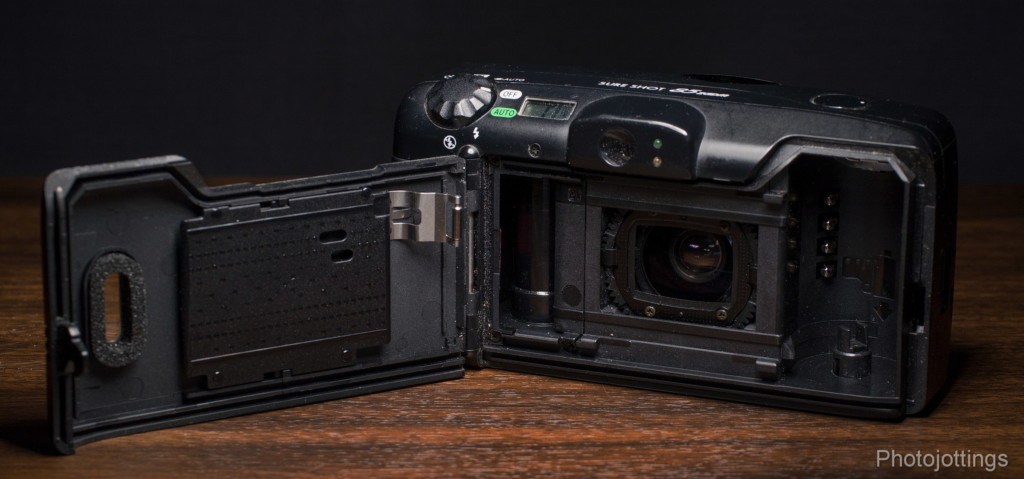
With the back open you can see the camera has some decent features like a real film pressure plate, a spring steel film tensioner and thick light sealing foam.

The red-eye reduction light is actually a little bulb inside the flash housing that runs continuously during a half press, and about 1 second after a full stroke of the shutter button. The manual states it’s good for up to 6′ (2m), but that’s probably stretching it. In this picture the lens is extended to the 38mm position.
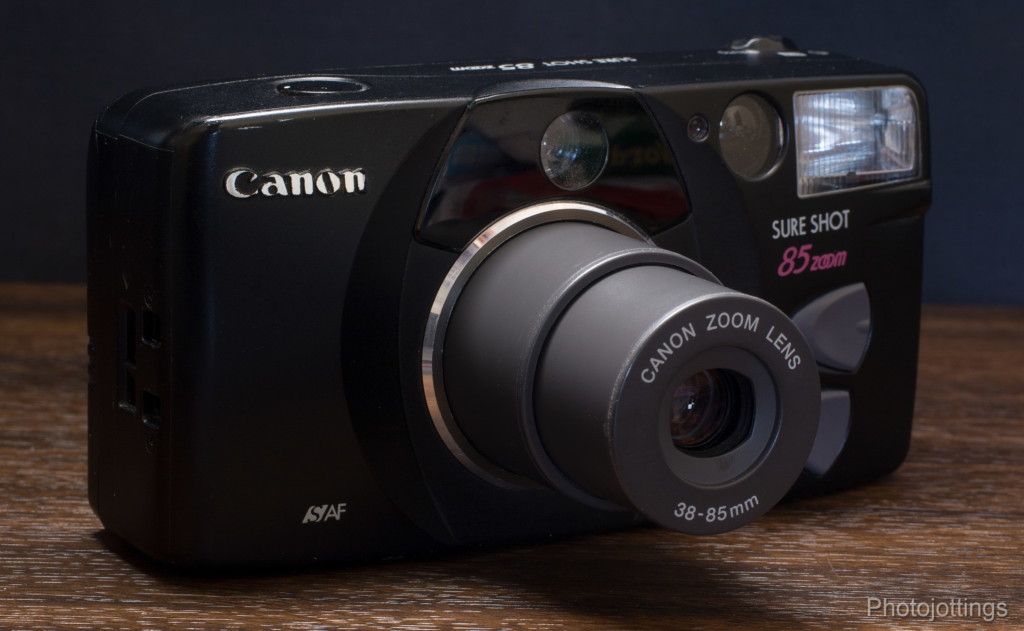
Here the lens is extended to 85mm. With the power on and zoomed in, the camera will automatically zoom back to 38mm after four minutes of inactivity. The lens will stay in the 38mm position indefinitely if you forget to turn it off; fortunately, there is no battery drain. As stated above, the zoom feature has five settings, probably about 38mm, 45mm, 55mm, 70mm, and 85mm. There are no in-between settings.
Here are some test images scanned on a Nikon Super Coolscan 9000 ED. All are 3000 pixels wide; there is no additional resolution from scanning at a higher sample rate. Click for larger images.
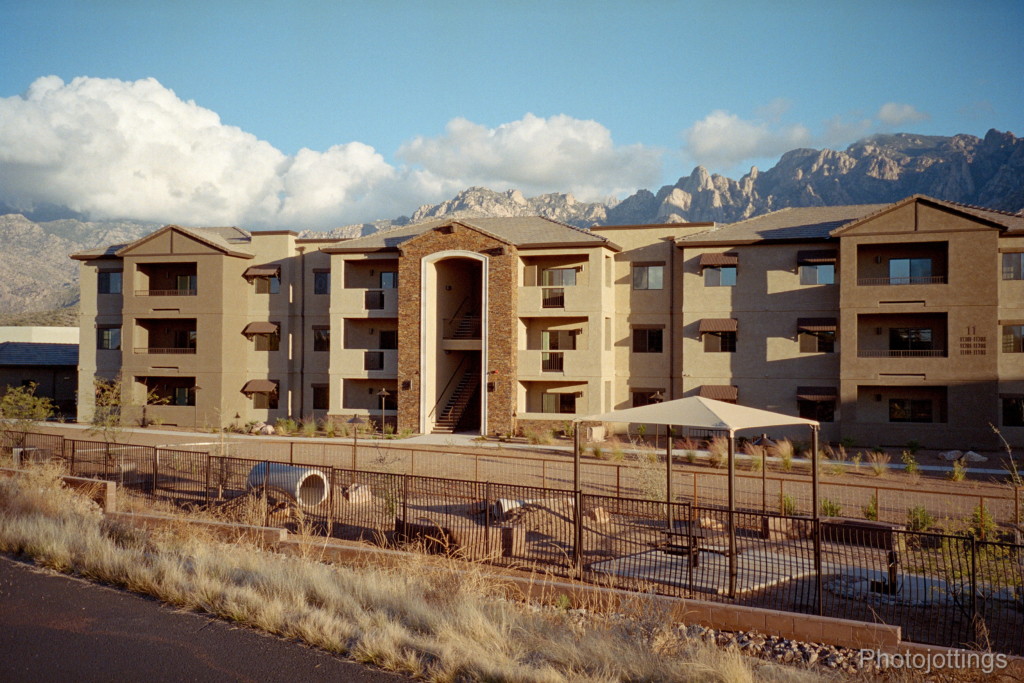
Corrections center; 38mm using Kodak UltraMax 400 film.

Close focus. Check out the weird star shaped background blur, especially along the left the the secondary tree trunk in the back. Kodak Portra 160.

A river doesn’t run through it, unless it’s mid to late summer. Taken at 85mm, using Kodak UltraMax 400 film.

Old Catalina Hwy, about 38mm using Kodak Portra 160 film. Notice the shadow differences between this Portra film and the UltraMax 400 above and below.
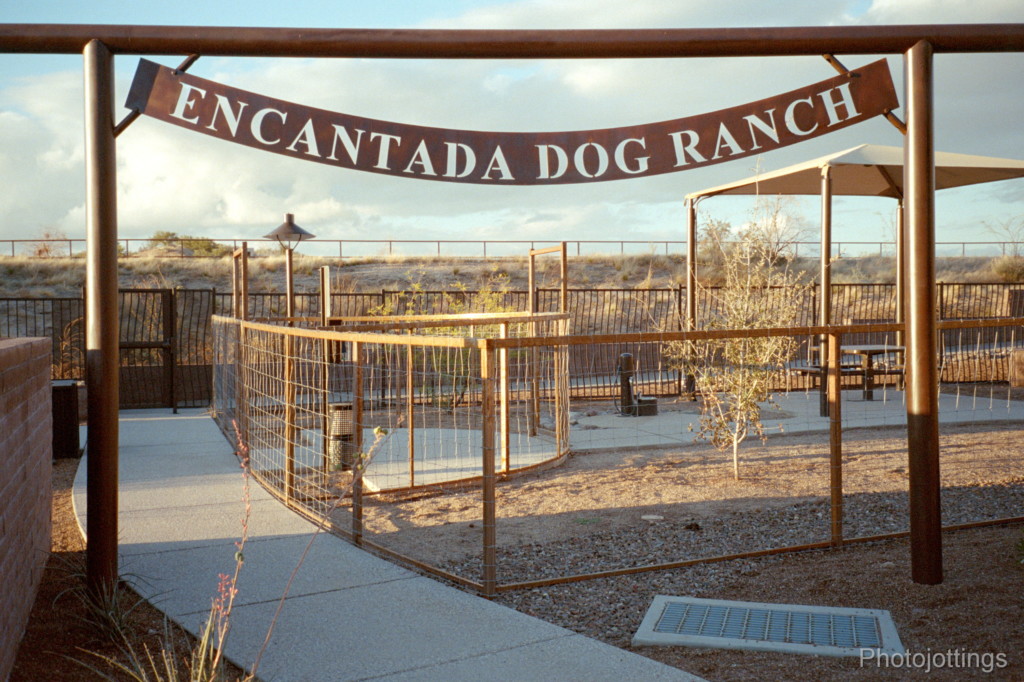
The Dog Pound Ranch. I see some mild pincushion distortion at 38mm along the top pipe. Kodak UltraMax 400 film.

Wash-out at the wash. Check out the odd shaped aperture ghost at the top center. Kodak Portra 160.
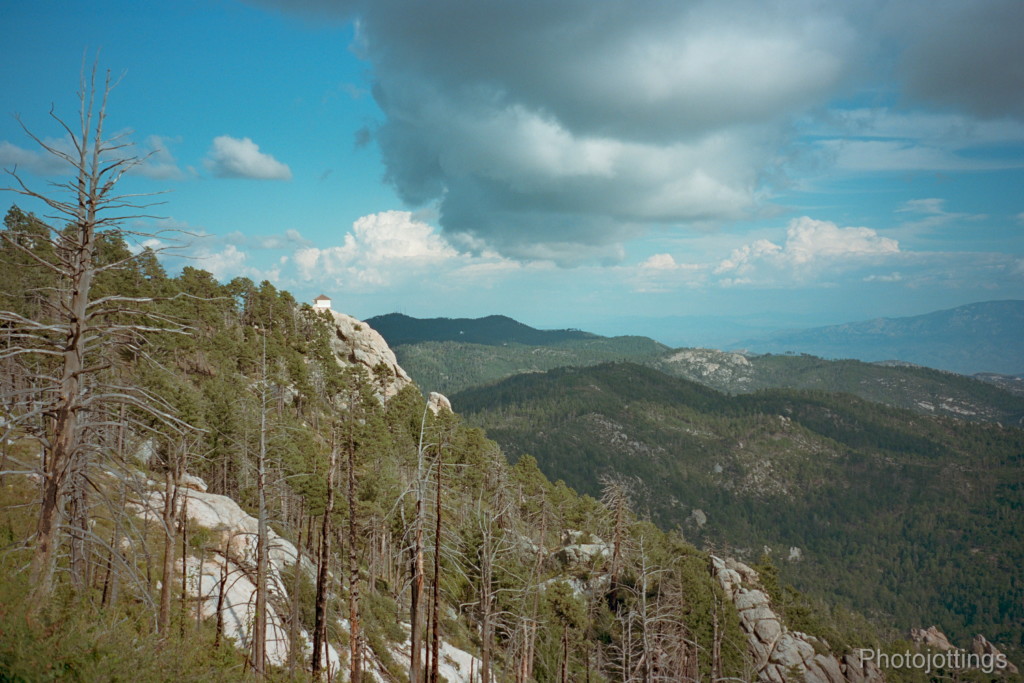
Little house on the rocks at 85mm. Kodak Portra 160.
Conclusion.
The Canon Sure Shot 85 Zoom is very impressive considering you can get them really cheap through ebay or garage sales. For the price of a pack of cigarettes, you can have a nice quality vacation or snap shot camera that will give you excellent prints up to 8″x10.”
Pluses include fast and accurate AF, excellent exposure metering for print film, (I did not try slide film, but I’m guessing it would do a good job of metering for that type of film). The ability to turn the flash on or off is quite useful, and the flash is reasonably powerful. The six element lens is surprisingly sharp at all focal lengths, and exhibits low color fringing, distortion, and light fall off; again, not bad for a $5-10 garage sale camera!!
I appreciate the tripod socket, but I doubt I’d ever do any low light shooting with this camera, the maximum 2 seconds isn’t long enough for low light conditions with the F/4.2 or F/8.7 apertures, plus, if you use the self timer, the maximum shutter speed is only 1/2 second. A couple of negatives to report; the mode dial is a pain in the butt to turn, the movement is restrained way too much, and it’s too short and flat for adult finger manipulation; but it’d be great for little child like fingers. Also, the viewfinder is usable, but a bit on the diminutive side, and not very bright. Oh well, one can’t have everything on their wish list right?
Bottom line; the Canon Sure Shot 85 Zoom really shines, especially when using clean and colorful fine grain film like Kodak Ektar, Portra, or even Fuji 400h. B&H, Amazon, eBay.
Please consider buying your goodies through my links, doing so helps support the site, thanks!